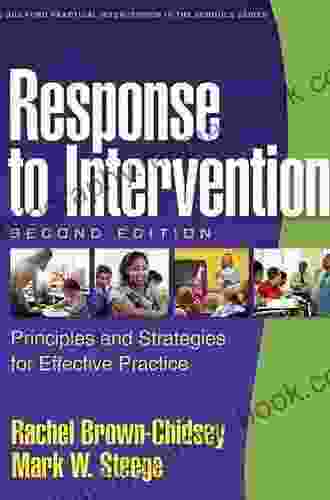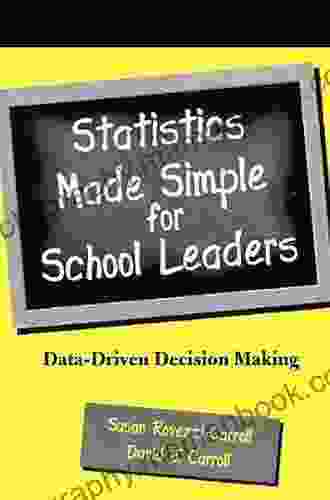Statistics Made Simple for School Leaders

In the ever-changing landscape of education, school leaders are faced with a multitude of challenges and opportunities. Data-driven decision-making has become increasingly essential for effective leadership, and statistics play a crucial role in this process. This article aims to provide a comprehensive guide to statistics for school leaders, covering key concepts, statistical methods, and practical applications in the field of education. By gaining a solid understanding of statistics, school leaders can become more informed and strategic in their decision-making, ultimately improving student outcomes.
4.1 out of 5
| Language | : | English |
| File size | : | 3187 KB |
| Text-to-Speech | : | Enabled |
| Screen Reader | : | Supported |
| Enhanced typesetting | : | Enabled |
| Word Wise | : | Enabled |
| Print length | : | 161 pages |
Key Concepts in Statistics
Before delving into statistical methods, it is essential to establish a foundation by understanding key statistical concepts. These include:
- Population and Sample: A population refers to the entire group of interest, while a sample is a subset of the population that is used for data collection and analysis.
- Variable: A variable is a characteristic or attribute that can vary across individuals or groups. Variables can be quantitative (numerical) or qualitative (non-numerical).
- Data: Data is the information collected about the variables of interest.
- Distribution: A distribution describes how data is spread out. Common distributions include normal, skewed, and bimodal distributions.
- Central Tendency: Central tendency measures summarize the "average" or typical value in a distribution. Common measures include mean, median, and mode.
- Variability: Variability measures describe how spread out the data is around the central tendency. Common measures include range, standard deviation, and variance.
- Hypothesis Testing: Hypothesis testing is a statistical method used to determine whether there is evidence to support a particular claim or hypothesis.
- Statistical Significance: Statistical significance indicates the probability that the observed results are due to chance or to a meaningful difference.
Statistical Methods for School Leaders
With a grasp of key concepts, school leaders can begin to explore various statistical methods that are particularly relevant to the field of education. These include:
- Descriptive Statistics: Descriptive statistics summarize and describe the data in a meaningful way. This includes measures of central tendency, variability, and data distribution.
- Inferential Statistics: Inferential statistics allow researchers to make inferences about the population based on the data collected from a sample. This includes hypothesis testing, confidence intervals, and regression analysis.
- Correlation Analysis: Correlation analysis measures the relationship between two or more variables. It helps determine whether changes in one variable are associated with changes in another.
- Regression Analysis: Regression analysis is a statistical technique used to predict the value of one variable (dependent variable) based on the values of other variables (independent variables).
- Analysis of Variance (ANOVA): ANOVA is a statistical technique used to compare the means of two or more groups. It is particularly useful for determining whether there are significant differences between groups.
Practical Applications of Statistics in Education
Statistics has a wide range of practical applications in education. School leaders can leverage statistical methods to:
- Identify Academic Achievement Gaps: Data analysis can help identify students who are struggling academically and require additional support.
- Evaluate the Effectiveness of Interventions: Statistical methods can evaluate the effectiveness of educational interventions and programs, helping schools make informed decisions about resource allocation.
- Predict Student Success: Regression analysis can help predict student success based on factors such as prior performance, demographics, and school environment.
- Create Personalized Learning Plans: By analyzing student data, schools can tailor learning plans to individual student needs and abilities.
- Inform Policy Decisions: Statistical analysis can provide evidence to support policy decisions related to school funding, curriculum design, and teacher professional development.
Statistics is an indispensable tool for school leaders in making data-driven decisions. By gaining a solid understanding of statistical concepts and methods, school leaders can become more effective in identifying areas for improvement, evaluating interventions, and ultimately improving student outcomes. The practical applications of statistics in education extend across a wide range of areas, from identifying academic gaps to creating personalized learning plans. As schools continue to face new challenges and opportunities, statistics will remain a critical resource for school leaders to navigate the ever-changing educational landscape.
4.1 out of 5
| Language | : | English |
| File size | : | 3187 KB |
| Text-to-Speech | : | Enabled |
| Screen Reader | : | Supported |
| Enhanced typesetting | : | Enabled |
| Word Wise | : | Enabled |
| Print length | : | 161 pages |
Do you want to contribute by writing guest posts on this blog?
Please contact us and send us a resume of previous articles that you have written.
 Top Book
Top Book Novel
Novel Fiction
Fiction Nonfiction
Nonfiction Literature
Literature Paperback
Paperback Hardcover
Hardcover E-book
E-book Audiobook
Audiobook Bestseller
Bestseller Classic
Classic Mystery
Mystery Thriller
Thriller Romance
Romance Fantasy
Fantasy Science Fiction
Science Fiction Biography
Biography Memoir
Memoir Autobiography
Autobiography Poetry
Poetry Drama
Drama Historical Fiction
Historical Fiction Self-help
Self-help Young Adult
Young Adult Childrens Books
Childrens Books Graphic Novel
Graphic Novel Anthology
Anthology Series
Series Encyclopedia
Encyclopedia Reference
Reference Guidebook
Guidebook Textbook
Textbook Workbook
Workbook Journal
Journal Diary
Diary Manuscript
Manuscript Folio
Folio Pulp Fiction
Pulp Fiction Short Stories
Short Stories Fairy Tales
Fairy Tales Fables
Fables Mythology
Mythology Philosophy
Philosophy Religion
Religion Spirituality
Spirituality Essays
Essays Critique
Critique Commentary
Commentary Glossary
Glossary Bibliography
Bibliography Index
Index Table of Contents
Table of Contents Preface
Preface Introduction
Introduction Foreword
Foreword Afterword
Afterword Appendices
Appendices Annotations
Annotations Footnotes
Footnotes Epilogue
Epilogue Prologue
Prologue Colin Howard
Colin Howard Robbin Gourley
Robbin Gourley Uncle Sam
Uncle Sam Judith Carter
Judith Carter Alexander Soifer
Alexander Soifer Blade Pen
Blade Pen John Yunker
John Yunker Samuel Carroll
Samuel Carroll Chuck Dixon
Chuck Dixon Rachel Brown Chidsey
Rachel Brown Chidsey Kennette Thigpen
Kennette Thigpen Hayden Trenholm
Hayden Trenholm Hampton Sides
Hampton Sides Scott Hershovitz
Scott Hershovitz Lp Snyder
Lp Snyder Moliere
Moliere Tim Flanagan
Tim Flanagan Sam Fury
Sam Fury Demelza Carlton
Demelza Carlton Kiana Azizian
Kiana Azizian
Light bulbAdvertise smarter! Our strategic ad space ensures maximum exposure. Reserve your spot today!

 Johnny TurnerRodney Stone Surazeus Astarius: A Legendary Hero from the Chronicles of Lore
Johnny TurnerRodney Stone Surazeus Astarius: A Legendary Hero from the Chronicles of Lore
 Frank MitchellCrochet Owl Baby Bottle Cozy Crochet Pattern: A Hoot-astic Way to Protect...
Frank MitchellCrochet Owl Baby Bottle Cozy Crochet Pattern: A Hoot-astic Way to Protect... Kenzaburō ŌeFollow ·14.8k
Kenzaburō ŌeFollow ·14.8k Eli BlairFollow ·8.2k
Eli BlairFollow ·8.2k Robert ReedFollow ·4.9k
Robert ReedFollow ·4.9k James GrayFollow ·14.1k
James GrayFollow ·14.1k Bruce SnyderFollow ·12.4k
Bruce SnyderFollow ·12.4k Barry BryantFollow ·2k
Barry BryantFollow ·2k Jeffrey CoxFollow ·8.2k
Jeffrey CoxFollow ·8.2k Lawrence BellFollow ·6.7k
Lawrence BellFollow ·6.7k

 Patrick Rothfuss
Patrick RothfussHow to Make a Million Dollars: No Secrets
Making a million dollars...

 Robert Heinlein
Robert HeinleinResponse to Intervention, Second Edition: RTI in Practice
A Comprehensive Resource for Educators and...

 Timothy Ward
Timothy WardUnravel the Gripping Assassination Thriller Bursting with...
Prepare yourself for a...
4.1 out of 5
| Language | : | English |
| File size | : | 3187 KB |
| Text-to-Speech | : | Enabled |
| Screen Reader | : | Supported |
| Enhanced typesetting | : | Enabled |
| Word Wise | : | Enabled |
| Print length | : | 161 pages |














